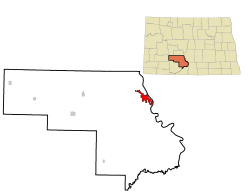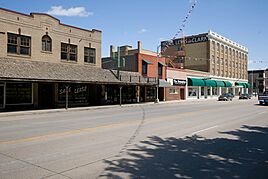Mandan, North Dakota facts for kids
Quick facts for kids
Mandan, North Dakota
|
||
|---|---|---|
|
Downtown Mandan, 2009
Mandan City Hall
|
||
|
|
||
| Motto(s):
"Where the West Begins"
|
||

Location of Mandan, North Dakota
|
||
| Country | United States | |
| State | North Dakota | |
| County | Morton | |
| Founded | 1879 | |
| Incorporated | February 24, 1881 | |
| Area | ||
| • City | 13.665 sq mi (35.392 km2) | |
| • Land | 13.517 sq mi (35.009 km2) | |
| • Water | 0.148 sq mi (0.384 km2) | |
| Elevation | 1,647 ft (502 m) | |
| Population
(2020)
|
||
| • City | 24,206 | |
| • Estimate
(2023)
|
24,586 | |
| • Density | 1,818.95/sq mi (702.31/km2) | |
| • Urban | 98,198 (US: 316th) | |
| • Metro | 135,786 (US: 305th) | |
| Time zone | UTC−6 (Central (CST)) | |
| • Summer (DST) | UTC−5 (CDT) | |
| ZIP Code |
58554
|
|
| Area code(s) | 701 | |
| FIPS code | 38-49900 | |
| GNIS feature ID | 1036146 | |
| Sales tax | 7.25% | |
| Highways | I-94, I-94 Bus., I-194, ND 6, ND 1806 | |
Mandan is a city in North Dakota, located on the western side of the Missouri River. It was founded in 1879 and became the main city for Morton County in 1881. In 2020, about 24,206 people lived there. Mandan is right across the Missouri River from Bismarck. Together, they form a larger metropolitan area.
Contents
Naming the City of Mandan
The city of Mandan is named after the historic Mandan people. They are a group of Native Americans who lived in this area for a very long time. Today, the Mandan people are part of the Three Affiliated Tribes of the Fort Berthold Reservation. This reservation is located along the upper Missouri River in western North Dakota. Many Mandan people also live in cities like Mandan itself. In 2010, almost 5% of the people in Mandan identified as Native American.
Long ago, a Mandan village existed at the base of a hill in east Mandan. This village was recorded as early as 1738. It was known by names like Good Fur Robe, Crying Hill, and Two Face Stone. It was one of six Mandan villages located on the west side of the river.
There is some debate about who officially named the city. Some say John Andrew Rea, a newspaper editor and land office worker, helped create the name with railroad engineer Thomas L. Rosser. Others believe Frederic Gerard is responsible. Gerard was married to an Arikara/Ree woman and was one of the first county officials. No matter who officially named it, the name Mandan has been used ever since.
History of Mandan
Early Beginnings
Native American groups had lived along the river in this area for thousands of years. The first European explorer to arrive was a Frenchman named Sieure de la Verendyre in 1738. Later, in the early 1800s, more explorers and traders came. Famous visitors included the Lewis and Clark Expedition in 1804 and 1806.
To protect the new railroad lines and settlers, the U.S. Army built forts nearby. Fort McKeen was built in 1873. It was later renamed Fort Abraham Lincoln and became a cavalry post. A town called Lincoln grew next to the fort.
In 1872, the Northern Pacific Railroad planned to cross the Missouri River. People rushed to buy land where the new city would be built. However, a financial crisis delayed the bridge project. Once the bridge location was set, a work camp appeared on the west riverbank in December 1878. This camp also served as the base for surveying the railroad line further west.
On March 3, 1879, the post office moved to the railroad's chosen city site. This new site was near Mandan's first railroad station. The city of Mandan was officially formed on February 24, 1881. It was named for the "people of the bank," or the Mantani Indians. Mandan then became the county seat for Morton County. After the railroad was finished in 1881, Fort Abraham Lincoln was no longer needed and closed in 1891. The town of Lincoln also slowly disappeared.
Transportation Development
In the early days, the Missouri River was the main way to travel and transport goods. Even after the railroad arrived in the 1870s, the river remained important. Steamboats used coal from a mine near Sims, west of Mandan. They also bought wood from local farmers.
Bellows Landing, now the site of the R.M. Heskett Power Station, was a major refueling spot for steamboats. It was a busy place as early as 1832. Regular steamboat service on the Missouri River began in 1860. The U.S. government took over Bellows Landing in the late 1870s and renamed it Rock Haven. They improved the area with dry-dock and boat repair facilities. This made it the best landing on the river. It was a safe and permanent harbor, even when the river ice broke up in spring. It stopped operating in 1934.
Recent Times
In 2013, Mandan was chosen as a finalist in the "Most Patriotic City" competition by Rand McNally. The Bismarck-Mandan area has often been ranked highly on lists like Forbes "Best Small Places for Business and Careers." It has also been included in CNN Money's list of the top 100 places to live.
Geography and Climate
Mandan covers about 13.665 square miles (35.392 square kilometers). Most of this area is land, with a small amount of water.
Mandan's Climate
Mandan has a climate with big changes in temperature throughout the year. Summers are warm to hot and often humid. Winters are cold, sometimes very cold. This type of climate is called a humid continental climate.
| Climate data for Mandan, North Dakota (1991–2020 normals, extremes 1913–present) | |||||||||||||
|---|---|---|---|---|---|---|---|---|---|---|---|---|---|
| Month | Jan | Feb | Mar | Apr | May | Jun | Jul | Aug | Sep | Oct | Nov | Dec | Year |
| Record high °F (°C) | 63 (17) |
68 (20) |
82 (28) |
94 (34) |
102 (39) |
110 (43) |
115 (46) |
109 (43) |
104 (40) |
96 (36) |
80 (27) |
66 (19) |
115 (46) |
| Mean daily maximum °F (°C) | 22.5 (−5.3) |
27.1 (−2.7) |
39.6 (4.2) |
54.1 (12.3) |
66.5 (19.2) |
76.0 (24.4) |
82.6 (28.1) |
81.8 (27.7) |
72.1 (22.3) |
56.1 (13.4) |
39.9 (4.4) |
27.4 (−2.6) |
53.8 (12.1) |
| Daily mean °F (°C) | 12.6 (−10.8) |
16.7 (−8.5) |
29.0 (−1.7) |
42.3 (5.7) |
54.5 (12.5) |
64.5 (18.1) |
70.3 (21.3) |
68.7 (20.4) |
59.0 (15.0) |
44.1 (6.7) |
29.5 (−1.4) |
17.9 (−7.8) |
42.4 (5.8) |
| Mean daily minimum °F (°C) | 2.7 (−16.3) |
6.4 (−14.2) |
18.3 (−7.6) |
30.4 (−0.9) |
42.6 (5.9) |
53.0 (11.7) |
58.0 (14.4) |
55.5 (13.1) |
45.8 (7.7) |
32.1 (0.1) |
19.1 (−7.2) |
8.4 (−13.1) |
31.0 (−0.6) |
| Record low °F (°C) | −43 (−42) |
−46 (−43) |
−30 (−34) |
−8 (−22) |
13 (−11) |
28 (−2) |
36 (2) |
32 (0) |
14 (−10) |
−14 (−26) |
−26 (−32) |
−46 (−43) |
−46 (−43) |
| Average precipitation inches (mm) | 0.38 (9.7) |
0.40 (10) |
0.59 (15) |
1.27 (32) |
2.59 (66) |
3.44 (87) |
3.24 (82) |
2.19 (56) |
1.64 (42) |
1.47 (37) |
0.63 (16) |
0.52 (13) |
18.36 (466) |
| Average precipitation days (≥ 0.01 in) | 4.3 | 4.1 | 4.3 | 6.4 | 9.3 | 10.7 | 8.8 | 6.8 | 6.1 | 6.0 | 3.6 | 4.7 | 75.1 |
| Source: NOAA | |||||||||||||
People of Mandan
| Historical population | |||
|---|---|---|---|
| Census | Pop. | %± | |
| 1880 | 239 | — | |
| 1890 | 1,328 | 455.6% | |
| 1900 | 1,658 | 24.8% | |
| 1910 | 3,873 | 133.6% | |
| 1920 | 4,336 | 12.0% | |
| 1930 | 5,037 | 16.2% | |
| 1940 | 6,685 | 32.7% | |
| 1950 | 7,298 | 9.2% | |
| 1960 | 10,525 | 44.2% | |
| 1970 | 11,093 | 5.4% | |
| 1980 | 15,513 | 39.8% | |
| 1990 | 15,177 | −2.2% | |
| 2000 | 16,718 | 10.2% | |
| 2010 | 18,331 | 9.6% | |
| 2020 | 24,206 | 32.0% | |
| 2023 (est.) | 24,586 | 34.1% | |
| U.S. Decennial Census 2020 Census |
|||
In 2022, Mandan had about 9,746 households. The average household had 2.42 people. The median household income was $78,077. About 9.5% of the city's population lived below the poverty line. About 72.7% of people had jobs. Also, 93.9% of the population had a high school diploma, and 28.2% had a bachelor's degree or higher.
The most common ancestries reported by people in Mandan were German (46.4%), Norwegian (13.6%), and Irish (8.4%). The median age in the city was 35.6 years old.
Population in 2020
In 2020, Mandan had 24,206 people. There were 10,222 households. The city had about 1,790.8 people per square mile. The racial makeup of the city was mostly White (84.82%). Other groups included African American (1.81%), Native American (5.02%), Asian (0.65%), and Pacific Islander (0.13%). About 5.68% of people were from two or more races. People of Hispanic or Latino background made up 4.77% of the population. About 22.8% of residents were under 18 years old. About 15.5% were 65 years or older.
Mandan's Economy
The area around Mandan has a lot of agriculture. In the past, Mandan had many grain elevators and a flour mill, but these are gone now. The city still supports farming with livestock sales, farm equipment dealers, and financial services. The railroad was very important for the city's growth. It helped farming, businesses, and industries grow.
Today, Mandan has many different types of businesses. These include food processing, oil refining, and making electricity. There are also companies that develop software and do manufacturing. Many professional services are available for residents. A federal institution and a women's state prison are also located near the city.
Information Services
National Information Solutions Cooperative (NISC) is a technology company in Mandan. It creates software and hardware for utility companies and broadband providers. NISC helps with things like billing and engineering. For 18 years in a row, NISC has been named one of the "Best Places to Work in IT." Over 450 people work at NISC's campus in Mandan, making it the city's second-largest employer.
Laducer & Associates, Inc. is another big employer. This company works with large amounts of information, especially for the federal government.
Energy Industry
A Marathon Petroleum oil refinery is located north of Mandan. It started operating in 1954. Today, it processes about 73,800 barrels of North Dakota crude oil each day. It turns this oil into different petroleum products. The refinery has changed owners several times and is now part of Marathon Petroleum. About 250 people work at the refinery.
R.M. Heskett Station is a power plant operated by Montana-Dakota Utilities Co. It is located along the Missouri River. In the past, it used coal to make most of its power. The coal-fired units were taken down in 2022 and 2023. Now, the station uses natural gas to generate electricity. Two natural gas-powered units were added in 2014 and 2023. The plant is named after R.M. Heskett, who founded Montana-Dakota Utilities Co.
Government Offices
Mandan is the county seat for Morton County. This means that all the main government offices for the county are located here. Morton County employs about 170 people. The City of Mandan offices employ about 140 people.
The Northern Great Plains Research Station was started in 1912. It is the second-largest federal dry land experimental station in the country. Here, scientists study dryland farming and develop new types of grains and fruits. About 20 people work at this station.
The North Dakota Youth Correctional Center is a facility for young people. It can hold up to 107 youth who have been sent there by the Juvenile Courts. The campus has cottages, education facilities, a gym, and a chapel. Before 1947, this facility also served as an orphanage for children.
Transportation in Mandan
Freight Trains
The city of Mandan was first built to support the Northern Pacific Railroad. A major maintenance facility was set up in Mandan in 1881. This helped the railroad operate from the Missouri River west to Montana. The Northern Pacific later became part of the BNSF Railway, which still operates the railroad facilities in Mandan today. Over 320 BNSF employees work in Mandan.
Public Transportation
Bis-Man Transit provides bus services in Mandan. They have regular routes and also offer rides that you can book.
Passenger Train Service
Mandan used to be a scheduled meal stop for the Northern Pacific Railway's passenger trains, starting in 1882. This service was later provided by Amtrak. However, Amtrak stopped its passenger service through this part of the state in 1979. The current train station and lunchroom were built in 1928 and 1930.
Education in Mandan
Mandan Public Schools runs several schools in the city. These include Roosevelt, Mary Stark, Lewis & Clark, Ft. Lincoln, Custer, and Red Trail Elementary Schools. There is also Mandan Middle School and Mandan High School. The Brave Center Academy offers night school. In 2016, the Mandan Public School District was the largest employer in Morton County, with about 700 employees.
The Catholic churches in Mandan also operate two private schools for students in kindergarten through sixth grade: Christ the King School and St. Joseph School.
Bismarck State College has two campuses in Mandan. These campuses focus on job training and vocational education. For example, they have programs for mechanical maintenance and electrical lineworkers.
Hospitals
Triumph Hospital Central Dakotas is a hospital in Mandan. It has 41 beds and provides critical care.
Local Media
Mandan shares its newspapers, radio stations, and TV channels with Bismarck.
Notable People from Mandan
- Frank L. Anders, a Medal of Honor winner and politician
- Marlo Anderson, who started National Day Calendar
- Henry Waldo Coe, an early doctor and friend of Theodore Roosevelt
- Tony Dean, a TV broadcaster and conservationist
- Ivan Dmitri, also known as Levon West, a famous artist and photographer
- Rachel Eckroth, a Grammy-nominated musician
- Ron Erhardt, who became a head coach for the New England Patriots
- Isabella Greenway, the first woman elected to the U.S. Senate from Arizona
- Heidi Heitkamp, a former U.S. Senator who lives near Mandan
- Tom Huff, a Washington State Representative
- Richard Longfellow, a Medal of Honor winner
- Eugene McCarthy, a U.S. Senator and Presidential candidate
- Abigail McCarthy, an academic and writer
- Arthur Peterson, Jr., an actor
- A. R. Shaw, an educator and politician
- Era Bell Thompson, an author and editor for Ebony magazine
See also
 In Spanish: Mandan (Dakota del Norte) para niños
In Spanish: Mandan (Dakota del Norte) para niños






